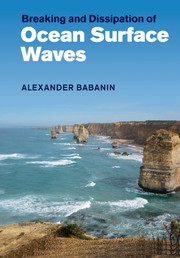Book contents
- Frontmatter
- Contents
- Preface
- 1 Introduction
- 2 Definitions for wave breaking
- 3 Detection and measurement of wave breaking
- 4 Fully nonlinear analytical theories for surface waves and numerical simulations of wave breaking
- 5 Wave-breaking probability
- 6 Wave-breaking severity
- 7 Energy dissipation across the wave spectrum
- 8 Non-dissipative effects of breaking on the wave field
- 9 Role of wave breaking in the air–sea interaction
- 10 Conclusions. What else do we need to know about wave breaking?
- References
- Index
1 - Introduction
Published online by Cambridge University Press: 25 October 2011
- Frontmatter
- Contents
- Preface
- 1 Introduction
- 2 Definitions for wave breaking
- 3 Detection and measurement of wave breaking
- 4 Fully nonlinear analytical theories for surface waves and numerical simulations of wave breaking
- 5 Wave-breaking probability
- 6 Wave-breaking severity
- 7 Energy dissipation across the wave spectrum
- 8 Non-dissipative effects of breaking on the wave field
- 9 Role of wave breaking in the air–sea interaction
- 10 Conclusions. What else do we need to know about wave breaking?
- References
- Index
Summary
Wind-generated waves are the most prominent feature of the ocean surface. As much as the oceans cover a major part of our planet, the waves cover all of the oceans. If there is any object in oceanography that does not need too much of a general introduction, it is the surface waves generated by the wind.
Being such a conspicuous entity, these waves, however, represent one of the most complex physical phenomena of nature. Three major processes are responsible for wave evolution in general, with many more whose significance varies depending on conditions (such as wave-bottom interaction which is only noticeable in shallow areas). The first process is energy and momentum input from the wind. The waves are generated by turbulent wind, and the turbulence is most important both for their initial creation and for subsequent growth (e.g. Miles', 1957; Miles, 1959, 1960; Phillips', 1957; Janssen, 1994, 2004; Belcher & Hunt, 1993; Belcher & Hunt, 1998; Kudryavtsev et al., 2001, among many others). There is, however, no fixed theory of turbulence to begin with. Experimentalists have to deal with tiny turbulent fluctuations of air which are of the order of 10-5-10-6 of the mean atmospheric pressure and which must be measured very close to the water surface, typically below the wave crests (e.g. Donelan et al., 2005).
- Type
- Chapter
- Information
- Breaking and Dissipation of Ocean Surface Waves , pp. 1 - 11Publisher: Cambridge University PressPrint publication year: 2011
- 1
- Cited by



